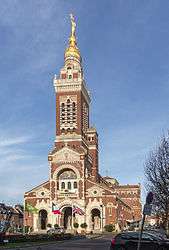Albert, Somme
| Albert | |
|---|---|
|
Basilica of Notre-Dame de Brebières | |
 Albert | |
|
Location within Hauts-de-France region  Albert | |
| Coordinates: 50°00′10″N 2°39′10″E / 50.0028°N 02.6528°ECoordinates: 50°00′10″N 2°39′10″E / 50.0028°N 02.6528°E | |
| Country | France |
| Region | Hauts-de-France |
| Department | Somme |
| Arrondissement | Péronne |
| Canton | Albert |
| Intercommunality | Pays du Coquelicot |
| Government | |
| • Mayor (2008–2014) | Stéphane Demilly |
| Area1 | 13.8 km2 (5.3 sq mi) |
| Population (2006)2 | 10,415 |
| • Density | 750/km2 (2,000/sq mi) |
| Time zone | CET (UTC+1) |
| • Summer (DST) | CEST (UTC+2) |
| INSEE/Postal code | 80016 / 80300 |
| Elevation |
42–121 m (138–397 ft) (avg. 67 m or 220 ft) |
|
1 French Land Register data, which excludes lakes, ponds, glaciers > 1 km² (0.386 sq mi or 247 acres) and river estuaries. 2 Population without double counting: residents of multiple communes (e.g., students and military personnel) only counted once. | |
Albert is a commune in the Somme department in Hauts-de-France in northern France.
It is located about halfway between Amiens and Bapaume.
History
Albert was founded as a Roman outpost, in about 54 BC. After being known by various forms of the name of the local river, the Ancre, it was renamed to Albert after it passed to Charles d'Albert, duc de Luynes. It was a key location in the Battle of the Somme in World War I, and World War I tourism is important for the town.
During World War I, the statue of Mary and the infant Jesus – designed by sculptor Albert Roze and dubbed the Golden Virgin – on top of the Basilica of Notre-Dame de Brebières was hit by a shell on January 15, 1915, and slumped to a near-horizontal position, where however it remained until further shelling in 1918 destroyed the tower. The British said that whoever made the statue fall would lose the war, whilst the Germans thought the opposite. A number of legends surrounding the Leaning Virgin developed among German, French, and British soldiers. The Leaning Virgin became an especially familiar image to the thousands of British soldiers who fought at the Battle of the Somme (1916), many of whom passed through Albert, which was situated three miles from the front lines. As The Golden Virgin it provided Henry Williamson with the title of an autobiographical book.[1]
In his letters home to his wife, Rupert Edward Inglis, who was a former rugby international and now a Forces Chaplain, describes passing through Albert:
We went through the place today (2 October 1915) where the Virgin Statue at the top of the Church was hit by a shell in January. The statue was knocked over, but has never fallen, I sent you a picture of it. It really is a wonderful sight. It is incomprehensible how it can have stayed there, but I think it is now lower than when the photograph was taken, and no doubt will come down with the next gale. The Church and village are wrecked, there’s a huge hole made by a Jack Johnson just outside the west door of the Church.[2]
The German army recaptured the town in March 1918 during the Spring Offensive; the British, to prevent the Germans from using the church tower as a machine gun post, directed their bombardment against 'imaginary' trenches the other side of the basilica as orders specifically stopped them from targeting buildings in the town; the line of fire took the artillery through the basilica, thus it was destroyed.[3] The statue fell in April 1918 and was never recovered. In August 1918 the Germans were again forced to retreat, and the British reoccupied Albert until the end of the war.
Albert was completely reconstructed after the war, including widening and re-orienting the town's main streets. The Basilica, however, was faithfully rebuilt according to its original design by Eduoard Duthoit, the son of the architect who had overseen its construction in 1885–95. The present statue is an exact replica of Roze's original design, and a war memorial designed by Roze and featuring an image of the Leaning Virgin can be seen in the Abri (Shelter) Museum, which houses souvenirs of the war. The underground shelters in which the museum is located served as protective bunkers for Albert's residents during aerial bombardments in World War II.
The city also appears in a short story, The Garden of Forking Paths, by the Argentine writer Jorge Luís Borges. In the story it is the location of a British artillery park that the Germans are about to bomb during World War I.
Twin towns
Albert is twinned with the British town of Ulverston in Cumbria.
The two towns regularly meet to play football at Easter with the Cyril Barker Shield being contested every year. Albert and Ulverston alternate the match's venue.
Albert is also twinned with the German towns of Aldenhoven and Niesky. Albert has also been adopted by the British city of Birmingham and the main street is named Rue de Birmingham.
See also
- Battle of Albert (disambiguation)
- Communes of the Somme department
- List of France's twin towns
- Vendémiaire Pavot
References
- ↑ fictionalised autobiographical sequence, A Chronicle of Ancient Sunlight
- ↑ "Rupert Edward Inglis". www.inglis.uk.com. Retrieved 16 April 2011.
- ↑ Customer. "The Legends and Traditions of the Great War: The Leaning Virgin of Albert". worldwar1.com. Retrieved 30 October 2014.
External links
| Wikivoyage has a travel guide for Albert. |
| Wikimedia Commons has media related to Albert, Somme. |
